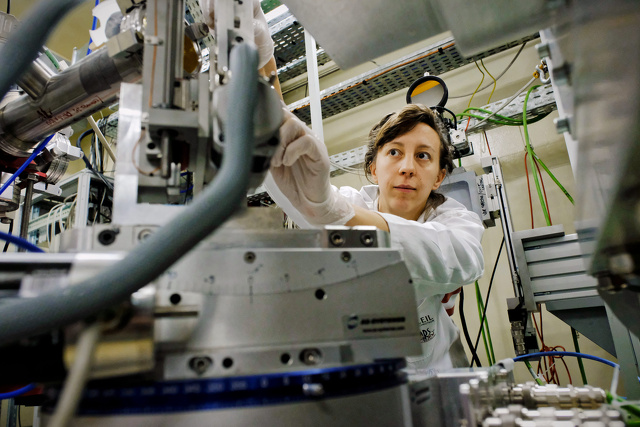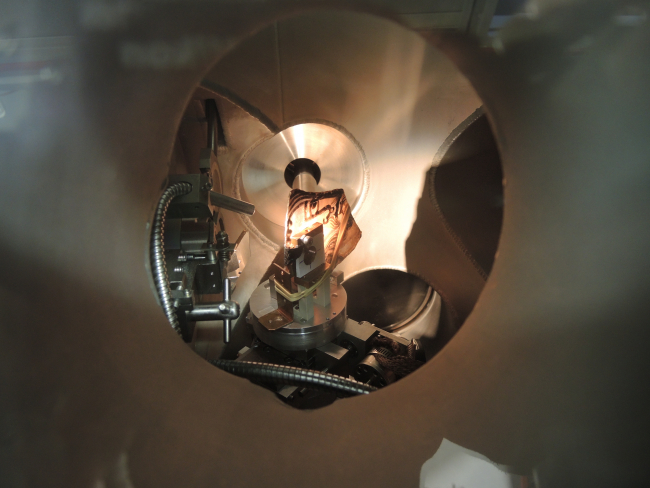During the fire of April 15, 2019, which destroyed a large part of the structure of Notre-Dame in Paris Cathedral, the 120 stained glass windows adorning the facades were preserved. However, the cloud of particles resulting from the fire left a deposit on their surface. The chemical nature of this deposit must now be identified before decontamination can be contemplated. This is why, one of the 8 work groups created as part of the scientific restoration work on the cathedral is dedicated to glass. Myrtille Hunault, beamline scientist working on the MARS beamline with a PhD in Materials science, was chosen for her expertise on medieval stained glass and represents Synchrotron SOLEIL.
The stained glass windows that illuminate Notre-Dame in Paris were created between the 13th and 19th centuries. The properties of the glass pieces (colours, transparency) vary according to the chemical composition and the reactions that occur between the different components of the glass during its melting and shaping. The surface of glass is particularly sensitive and subject to various alteration phenomena over time, as a result of environmental constraints (abrasion, corrosion, etc.). These alteration phenomena are the subject of scientific studies to guide the methods used by restorers.
After the fire that devastated Notre-Dame in Paris Cathedral, a major "scientific work site" was set up by the French Ministry of Culture so that research could be carried out, not only to help with its restoration but also to expand the existing body of information on the building. This scientific work site coordinated by the CNRS involves a team of 175 people from some fifty laboratories throughout France and is structured into eight thematic working groups. With significant research experience in the field of glass and stained glass, Myrtille Hunault, a scientist working on the Synchrotron SOLEIL MARS beamline, is one of 20 scientists in the glass working group, under the supervision of Claudine Loisel, head of the stained glass division at the Laboratoire des Recherches des Monuments Historiques (LRMH).

Myrtille Hunault, PhD in Materials science and Beamline scientist on MARS beamline at Synchrotron SOLEIL
Copyright: Synchrotron SOLEIL - Vincent MONCORGE
Myrtille Hunault has built up her expertise through her doctoral work on the colour of medieval stained glass. Notably, she determined the influence of the chemical composition of glass on the blue colour provided by cobalt, by means of X-ray absorption spectroscopy at the Advanced Photon Source synchrotron (Chicago) and spectroscopy in the UV and visible light range. Additional information on the conditions in which glass is made, such as the atmosphere of ancient furnaces, can be obtained by determining the degree of oxidation of certain elements such as iron or manganese. Following her participation in the first large-scale study on the colour of stained glass, as part of the restoration of the Sainte-Chapelle in Paris stained glass windows, Myrtille Hunault took part in an X-ray spectroscopy study conducted on the SOLEIL LUCIA beamline by the LRMH on a collection of stained glass windows representing the faces of figures, with the aim of understanding colour mastery by medieval glassmakers.

Caption: Piece of glass from a stained-glass window from Angers Cathedral (circa 1190-1210), installed in the vacuum chamber of the LUCIA beamline experimental station at Synchrotron SOLEIL.
On 19 and 20 October 2020, a preliminary consultation made it possible to compile an inventory and outline the objectives for each of the scientific work groups at Notre-Dame. Notably, the methodologies used to identify, collect and organise the various vestiges from the fire were addressed. In all fields, the researchers use state-of-the-art techniques to understand the damaged and preserved materials for the benefit of the restoration site, while gathering unique archaeological data. In the case of the stained glass windows, which were scheduled to be restored, LRMH’s primary objective was to coordinate their safekeeping, but part of the stained glass windows in the transept remain inaccessible. The development of a protocol for decontaminating the lead from the fumes of the fire is a priority to enable the building to be reopened.
The next step is to structure the research and implement it. For the stained glass windows of Notre-Dame in Paris, two main lines of work have been initiated. The first is the characterisation of the lead deposits, notably, for the purpose of optimising decontamination protocols, a characterisation studied in 2 research projects: (i) postdoctoral research entitled "PlombND" involving the LRMH and the Laboratoire Inter-universitaire des systèmes atmosphériques (LISA), and financed by the Île-de-France Region within the framework of its "major field of interest" (DIM) dedicated to "Ancient and Heritage Materials"; (ii) a thesis involving EDF, the Centre de Recherches et de Restauration des Musées de France (C2RMF) and the LRMH. The second axis involves updating understanding of the history of these stained glass windows of various origins and glass material as a whole.
In addition to these preliminary investigations, Myrtille Hunault has also been commissioned by the Délégation académique à l'action culturelle of Versailles rectorat to participate as part of the Journées académiques interprofessionnelles Patrimoine, culture scientifique & technique: "Notre-Dame: past, present, future" for secondary school teachers in all disciplines. In her lecture, Myrtille Hunault will present Synchrotron SOLEIL and its role in the study of heritage materials, using stained glass windows from the Middle Ages as an example. Initially scheduled for November 6, 2020, the event has been postponed to a later date due to the public health context linked to the CoViD-19 pandemic.
